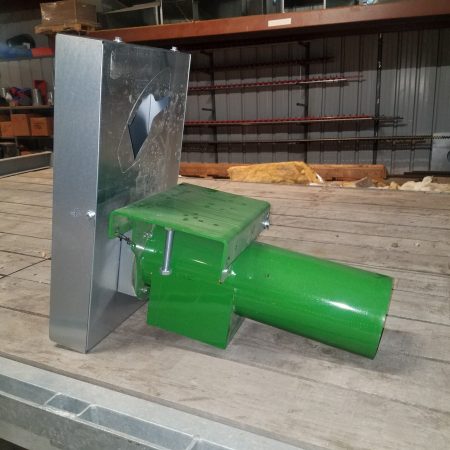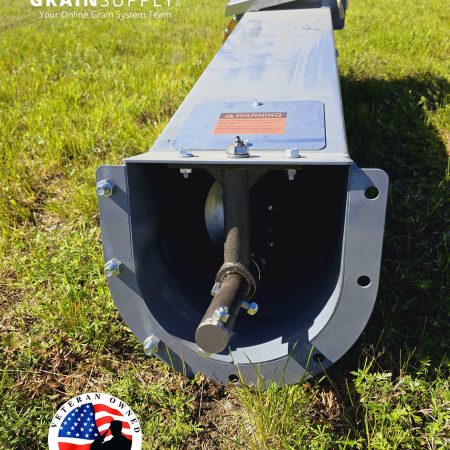Grain Bin Powerheads: Choosing the Right Style and Configuration for Efficient Grain Handling
Grain bins are essential for storing harvested crops safely and efficiently, but unloading those bins quickly and reliably is equally important. At the heart of every grain bin unload system is the powerhead—the mechanical drive unit responsible for powering the unload auger and often a sweep auger in flat-bottom bins. Selecting the right powerhead configuration and style is critical for ensuring smooth, efficient grain flow and maximizing operational uptime.
This essay explores the differences between tube-style and U-trough powerhead systems, the advantages of horizontal, inclined, and vertical powerhead configurations, and reviews leading brands such as Grain Saver, Sukup, and Brock that set the industry standard for quality and performance.
What Is a Grain Bin Powerhead?
A powerhead is the motorized component mounted at the end of a grain bin unload auger system. It houses the motor, gearbox, and drive components that rotate the auger, moving grain from the bin floor to an elevated discharge point. In flat-bottom bins with PowerSweep systems, the powerhead often also drives the sweep auger, which cleans out residual grain from the bin floor.
The powerhead’s design and configuration influence how efficiently the grain is moved, how easy the system is to maintain, and how well it integrates with the bin and surrounding equipment.
Tube-Style vs. U-Trough Powerhead Systems
Tube-style and U-trough are two common types of grain auger troughs driven by powerheads, and each offers distinct advantages.
Tube-Style Systems
Tube-style systems feature a round or cylindrical auger trough, typically smaller in diameter, with the auger housed inside. This design is compact and often less expensive to manufacture.
-
Advantages:
-
Simple, compact design saves space.
-
Often easier to retrofit on existing bins.
-
Generally lower initial cost.
-
-
Disadvantages:
-
Lower capacity due to smaller trough cross-section.
-
More prone to plugging or grain bridging, especially with fines or damp grain.
-
Less airflow beneath the bin floor, which can impact aeration efficiency.
-
U-Trough Systems
U-trough systems use a wider, U-shaped channel to house the auger, allowing for larger auger diameters and greater capacity.
-
Advantages:
-
Typically 12% to 15% higher capacity than tube systems.
-
Improved grain flow with reduced plugging risk.
-
Easier to inspect and maintain due to open or removable covers.
-
Better airflow beneath the bin floor, aiding aeration.
-
-
Disadvantages:
-
Larger footprint may require more space.
-
Usually higher initial cost.
-
For operations handling large volumes of grain or needing faster unload times, U-trough systems paired with a powerful, reliable powerhead offer significant efficiency gains.
Powerhead Configurations: Horizontal, Inclined, and Vertical
Choosing the correct powerhead orientation depends on the unloading needs, bin setup, and discharge location.
Horizontal Powerheads
Horizontal powerheads mount the motor and gearbox so the auger rotates on a horizontal axis. This is the most common configuration.
-
Advantages:
-
Ideal for unloading grain at or near ground level.
-
Straightforward design with simpler maintenance.
-
Good fit for most flat-bottom bins and direct conveyor or truck loading.
-
-
Best Use: When grain is discharged to ground conveyors, pits, or transport vehicles located close to the bin base.
Inclined Powerheads
Inclined powerheads are angled upward, allowing grain to be discharged at a height between horizontal and vertical configurations.
-
Advantages:
-
Allows unloading to elevated conveyors, pits, or trucks without additional equipment.
-
Can reduce the need for secondary lift conveyors.
-
-
Best Use: When discharge elevation is moderate, such as feeding grain to trailers or conveyors at intermediate heights.
Vertical Powerheads
Vertical powerheads position the auger to move grain straight upward.
-
Advantages:
-
Enables unloading directly into tall trucks, railcars, or elevators.
-
Minimizes footprint around the bin.
-
-
Best Use: For operations requiring vertical discharge with limited space or complex bin layouts.
Industry-Leading Brands: Grain Saver, Sukup, and Brock
When selecting a powerhead, quality and reliability are paramount. Three trusted names in the industry are Grain Saver, Sukup, and Brock.
Grain Saver
Grain Saver powerheads are known for rugged durability and smooth operation. Their units are designed for easy maintenance, with sealed bearings and corrosion-resistant finishes.
-
Notable Features:
-
Available in horizontal, inclined, and vertical configurations.
-
Compatible with both tube-style and U-trough systems.
-
Often paired with Grain Saver’s PowerSweep unload systems for integrated performance.
-
Grain Saver emphasizes versatility, making their powerheads popular among mid-sized farms and commercial operators seeking reliability at a competitive price.
Sukup
Sukup powerheads stand out for their robust engineering and long service life. The company offers a wide range of powerhead options tailored to various bin sizes and unloading requirements.
-
Notable Features:
-
Heavy-duty gearboxes designed for continuous operation.
-
Multiple mounting angles and trough compatibility.
-
Commonly used in large-scale commercial grain bins.
-
Sukup powerheads are favored for their strength and durability in demanding environments, often used in large grain elevators and commercial storage.
Brock
Brock powerheads are synonymous with high capacity and heavy-duty performance. Their 1500 Series, for example, supports large U-trough unload systems with power ratings that handle some of the largest grain bins in North America.
-
Notable Features:
-
High horsepower motors and reinforced gearboxes.
-
Optimized for U-trough systems, maximizing throughput.
-
Designed for quiet operation and easy maintenance.
-
Brock is the go-to brand for large commercial operations requiring maximum efficiency and minimal downtime.
Making the Right Choice
When selecting a grain bin powerhead, consider:
-
Bin size and capacity: Larger bins generally benefit from U-trough systems and higher horsepower powerheads.
-
Discharge height and layout: Choose horizontal for low-level discharge, inclined for mid-height, and vertical for high-elevation needs.
-
Grain type and moisture: Some systems handle fines and damp grain better than others.
-
Budget and maintenance preferences: Consider initial cost, ease of maintenance, and longevity.
Conclusion
The grain bin powerhead is a vital component that drives efficient grain unload operations. Understanding the differences between tube-style and U-trough systems, as well as the horizontal, inclined, and vertical powerhead configurations, enables grain handlers to tailor their equipment to operational demands.
Top brands like Grain Saver, Sukup, and Brock provide durable, high-quality powerheads designed to maximize grain flow, minimize downtime, and ensure safety. By choosing the right combination, operators can achieve faster unload times, reduce maintenance, and protect the quality of their stored grain.
Whether outfitting a new bin or upgrading an existing system, investing in the appropriate powerhead system ensures your grain handling operation runs smoothly season after season.


